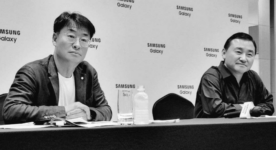In this guest post, Jukanlosreve dives into the reported internal rifts between Samsung’s MX and DS divisions, and how TM Roh is navigating them to do what’s best for Galaxy.
Galaxy flagship smartphones have almost always used memory modules from Samsung’s DS division, and with good reason. It’s been one of the leading suppliers of memory products in the world for a long time. This synergy provided many benefits to Samsung MX, but it appears there may now be trouble in paradise.
For those who are unaware, Samsung MX is what’s commonly referred to as the mobile division. It develops and sells Galaxy mobile devices. DS, or Device Solutions, is Samsung’s semiconductor division. It makes many semiconductor products, including memory chips.
A recent report revealed that most Galaxy S25 units may not use Samsung’s own memory chips. The mobile division is reportedly sourcing most of them from Micron, a semiconductor manufacturer based in the United States. Samsung DS will be a part of the supply chain but only as a secondary memory supplier.
Dual-sourcing is common in the industry. It enables companies to bring competition to their supply chains and lower component pricing. However, the decision to opt for Micron over DS might have more to do with internal conflicts and structural issues within Samsung.
It’s claimed that the semiconductor division attempted to supply MX with LPDDR5X RAM, which reportedly suffers from overheating and performance issues, at a price higher than that of competing products. DS has been struggling with profitability after selling its 1a-nanometer memory products at low prices to compete with Chinese semiconductor firms.
Internal conflict is reportedly brewing inside Samsung
Chinese memory makers have flooded the market with memory products priced at less than half of what Samsung charges. It couldn’t come at a worse time for the semiconductor division that’s also facing steep revenue declines in other areas of the business. To offset these losses, it has reportedly tried to charge higher prices to MX for components, leading to growing discontent within MX.
The challenges for MX don’t stop there. Due to performance issues with Exynos, MX has reportedly fully transitioned to Qualcomm’s Snapdragon 8 Elite for the Galaxy S25, which has already significantly increased production costs. Qualcomm is charging more for the Snapdragon 8 Elite so the mobile division would find it nearly impossible to maintain profitability on the new lineup if it also has to source more expensive memory modules.
Faced with this situation, MX has made a strategic decision to increase the use of Micron RAM in the Galaxy S25 to strengthen its bargaining power against DS. According to reports, most of the initial batch of S25 units will feature Micron RAM.
Pricing wasn’t the only factor in this decision. Micron’s RAM is rated higher in both performance and heat management. For MX, which must equip its flagship Galaxy S25 with top-performing components, adopting DS’s lower-performing DRAM on a large scale would have been a heavy burden.
What’s even more surprising is the level of internal conflict within Samsung. The report mentioned that last year, Samsung MX boss TM Roh personally visited the DS division to express his strong dissatisfaction, leading to a major dispute. This reflects Roh’s belief in equipping flagship models with only the best components. His stance against using underperforming in-house components can be seen as an effort to protect the Galaxy brand.
TM Roh is doing his best to protect the Galaxy brand
Countless reports have highlighted how MX effectively had no other option than to choose the Snapdragon 8 Elite chipset over the Exynos 2500 because the semiconductor division couldn’t improve on the chip yields. We need to be clear: TM Roh is not responsible for the failure of Exynos. The shortcomings of Exynos lie with Samsung’s foundry division, not with the MX division.
Samsung’s also having to balance the impact of the weaker Korean won currency. The Snapdragon chipset isn’t just more expensive. The company also needs to spend more in won to get the dollar equivalent for those imports. The memory pricing from DS might have been so high that even after higher import costs, it may still be cheaper to go with Micron for the bulk of its Galaxy S25 memory modules.
For years, TM Roh has faced criticism for allegedly prioritizing cost-cutting over an outright focus on shock and awe. However, this case reveals a different side of him: a leader who strives to create the best product possible within budget constraints. TM Roh is not just a corporate executive but a “Dark Knight” fighting to uphold the Galaxy brand.
Don’t blame TM Roh. He is not just managing a brand but protecting Samsung Galaxy. Without his decisive actions, the Galaxy’s reputation could have faced even greater risks. Samsung must address these internal conflicts and find a way for its divisions to work in harmony, restoring its true competitive edge.
Image credits: Samsung




